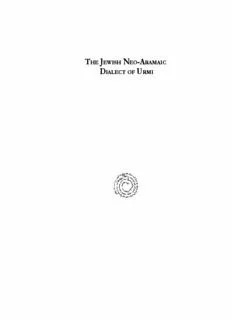
The Jewish Neo-Aramaic Dialect of Urmi PDF
Preview The Jewish Neo-Aramaic Dialect of Urmi
T J N -A he ewish eo rAmAic D U iAlecT of rmi GorGiAs Neo-ArAmAic sTUDies 2 General Editors Geoffrey Khan and Hezy Mutzafi The Jewish Neo-Aramaic Dialect of Urmi G K eoffrey hAN GorGiAs Press 2008 First Gorgias Press Edition, 2008 Copyright © 2008 by Gorgias Press LLC All rights reserved under International and Pan-American Copyright Conventions. No part of this publication may be reproduced, stored in a retrieval system or transmitted in any form or by any means, electronic, mechanical, photocopying, recording, scanning or otherwise without the prior written permission of Gorgias Press LLC. Published in the United States of America by Gorgias Press LLC, New Jersey ISBN 978-1-59333-425-3 ISSN 1935-4428 GorGiAs Press 180 Centennial Ave., Suite 3, Piscataway, NJ 08854 USA www.gorgiaspress.com Library of Congress Cataloging-in-Publication Data Khan, Geoffrey. The Jewish neo-Aramaic dialect of Urmi / Geoffrey Khan. -- 1st Gorgias Press ed. p. cm. -- (Gorgias neo-Aramaic studies ; 2) ISBN 978-1-59333-425-3 1. Aramaic language--Dialects--Iran--Urumiyah--Grammar. 2. Urumiyah (Iran)-- Languages. I. Title. PJ5282.K456 2008 492’.2--dc22 2008053356 The paper used in this publication meets the minimum requirements of the American National Standards. Printed in the United States of America For Nisan Aviv TABLE OF CONTENTS PREFACE....................................................................................................XVII INTRODUCTION.............................................................................................1 The Jews of Urmi....................................................................................1 The Neo-Aramaic Dialect of the Jews of Urmi........................................2 Written and Spoken Language................................................................2 The Place of Jewish Urmi within the Neo-Aramaic Dialects..................2 The Influence of Azeri Turkish and Kurdish...........................................7 Grammar and Texts................................................................................8 1. PHONOLOGY........................................................................................11 1.1. Consonant Phonemes.....................................................................11 Phoneme Inventory...............................................................................11 1.2. Vowel Phonemes............................................................................12 1.3. Suprasegmental Velarization.........................................................13 1.4. Notes on the Phonetic Realization of Selected Consonants...........20 1.4.1. /p/, /t/, /k/................................................................................20 1.4.2. /x/, /(cid:2)/.......................................................................................20 1.4.3. /q/..............................................................................................20 1.4.4. /w/..............................................................................................20 1.4.5. /h/..............................................................................................21 1.4.6. /n/..............................................................................................21 1.4.7. /r/...............................................................................................21 1.5. Phonetic Processes Relating to Voicing.........................................21 1.6. The Phonetic Realization of Vowels..............................................22 1.6.1. /i/...............................................................................................22 1.6.2. /(cid:3)/...............................................................................................22 1.6.3. /e/...............................................................................................22 1.6.4. /a/..............................................................................................22 1.6.5. /o/...............................................................................................23 1.6.6. /u/..............................................................................................23 1.7. Vowel Length.................................................................................23 VI TABLE OF CONTENTS 1.7.1. The Vowels /i/, /e/, /a/, /o/, /u/ in Open Syllables.................24 1.7.2. The Vowels /i/, /e/, /o/, /u/ in Closed Syllables.......................26 1.7.3. The Vowel /a/ in Closed Syllables.............................................27 1.7.4. The Vowel /(cid:3)/............................................................................28 1.8. Historical Background of Consonants............................................28 1.8.1. The BGDKPT Consonants...........................................................28 1.8.2. Pharyngals and Laryngals...........................................................33 1.8.3. Velarization................................................................................35 1.8.4. Diphthongs.................................................................................39 1.9. Gemination of Consonants............................................................39 1.9.1. Distribution of gemination.........................................................39 1.9.2. The Origin of Consonant Gemination.........................................40 1.10. Syllable Structure........................................................................42 1.10.1. Syllabic Patterns.......................................................................42 1.10.2. Epenthetic Vowels....................................................................44 1.10.3. Word Internal Syllable Boundaries...........................................45 1.11. Word Stress..................................................................................45 1.11.1. Nouns, Pronouns, Adjectives and Numerals.............................46 1.11.2. Adverbials.................................................................................47 1.11.3. Verbs........................................................................................49 1.12. Stress Groups...............................................................................52 1.12.1. Numeral + Counted Nominal..................................................52 1.12.2. Negator + Verb/Nominal/Adverbial.......................................52 1.12.3. Demonstrative + Nominal.......................................................53 1.12.4. Stress groups of three components...........................................53 2. PRONOUNS..........................................................................................55 2.1. Independent Personal Pronouns....................................................55 2.2. Demonstrative Pronouns...............................................................55 2.2.1. Near Deixis Demonstrative Pronouns.........................................55 2.2.2. Far Deixis Pronouns....................................................................56 2.3. Pronominal Suffixes on Nouns and Prepositions...........................56 2.4. The Independent Genitive Particle................................................58 2.5. Reflexive Pronoun.........................................................................58 2.6. Reciprocal Pronoun.......................................................................59 2.7. Interrogative Pronouns..................................................................59 3. COPULA................................................................................................61 3.1. Present Copula...............................................................................61 3.2. Inflected Deictic Particles..............................................................62 3.3. Negative Present Copula...............................................................63 TABLE OF CONTENTS VII 3.4. Negative Past Copula.....................................................................63 4. VERBS...................................................................................................65 4.1. Verbal Stems..................................................................................65 Stem I....................................................................................................65 Stem II...................................................................................................65 Quadriliteral I.......................................................................................66 Quadriliteral II (Marginal)....................................................................66 4.2. Inflectional Suffixes.......................................................................68 4.2.1. S-suffixes.....................................................................................68 4.2.2. L-suffixes.....................................................................................68 4.2.3. Inflection of the Present Base with S-suffixes.............................69 4.2.4. Inflection of the Intransitive Past Base with S-suffixes...............70 4.2.5. Inflection of the General Past Base with S-suffixes.....................71 4.2.6. Inflection of the General Past Base with L-suffixes.....................72 4.3. Comparative Excursus....................................................................73 4.4. Particles Combined with Verbs Derived from the Present and Past Bases......................................................................................75 4.4.1. Indicative Particle.......................................................................75 4.4.2. Future Particle............................................................................76 4.4.3. Deontic Particle..........................................................................76 4.4.4. Past Converter Suffix -wa............................................................76 4.5. Inflection of the Imperative...........................................................77 4.5.1. Stem I Verbs................................................................................77 4.5.2. Stem II Verbs..............................................................................77 4.5.3. Quadriliteral Verbs.....................................................................77 4.6. Inflection of the Resultative Participle..........................................78 4.6.1. Stem I Verbs................................................................................78 4.6.2. Stem II Verbs..............................................................................78 4.6.3. Quadriliteral Verbs.....................................................................78 4.7. Inflection of the Active Participle..................................................78 4.7.1. Stem I..........................................................................................79 4.7.2. Stem II.........................................................................................79 4.7.3. Quadriliteral...............................................................................79 4.8. Compound Verbal Forms Containing the Verb ‘to be’...................79 4.8.1. Copula Combined with Resultative Participle............................79 4.8.2. Copula Combined with Infinitive................................................83 4.9. Negation of Verbal Forms..............................................................84 4.10. Weak Verbs in Stem I...................................................................85 4.10.1. Verba Primae /(cid:2)/ (1)..............................................................85 4.10.2. Verba Primae /(cid:2)/ (2)..............................................................87 VIII TABLE OF CONTENTS 4.10.3. Verba Primae /y/.....................................................................89 4.10.4. Verba Mediae /y/.....................................................................91 4.10.5. Verba Tertiae /y/.....................................................................93 4.10.6. Primae /y/, Tertiae /y/............................................................96 4.10.7. Verba Mediae /w/....................................................................97 4.10.8. Verba Primae /(cid:2)/, Secundae /w/...........................................99 4.10.9. Verba Tertiae /w/..................................................................100 4.10.10. Verba Primae /y/, Tertiae /w/.............................................102 4.10.11. Verba Mediae /w/, Tertiae /y/............................................103 4.11. Weak Verbs in Stem II...............................................................105 4.11.1. Verba Primae /(cid:2)/..................................................................105 4.11.2. Verba Primae /y/...................................................................106 4.11.3. Verba Mediae /y/...................................................................108 4.11.4. Verba Tertiae /y/...................................................................110 4.11.5. Verba Mediae /w/..................................................................112 4.11.6. Verba Tertiae /w/..................................................................112 4.12. Weak Quadriliteral Verbs..........................................................112 4.12.1. Verba Primae /(cid:2)/..................................................................112 4.12.2. Verba Secundae /y/...............................................................114 4.12.3. Verba Quartae /y/..................................................................115 4.13. Irregular and Defective Verbs....................................................117 4.13.1. ‘to go’......................................................................................117 4.13.2. ‘to want’..................................................................................119 4.13.3. ‘to know’.................................................................................121 4.13.4. ‘to give’...................................................................................122 4.13.5. ‘to come’.................................................................................124 4.13.6. ‘to bring’.................................................................................127 4.13.7. ‘to enter’.................................................................................128 4.13.8. ‘to live’....................................................................................131 4.13.9. ‘to be’......................................................................................132 4.13.10. ‘to hit’...................................................................................134 4.13.11. ‘to be enough’.......................................................................135 4.13.12. ‘to be able’............................................................................136 4.14. Phrasal Verbs.............................................................................138 4.15. Pronominal Direct Object on Present Base Verbs......................138 4.16. Pronominal Direct Objects on General Past Base Verbs............139 4.16.1. Incorporated Pronominal Object............................................139 4.16.2. L-suffixes................................................................................139 4.17. Pronominal Direct Objects on Imperatives................................140 4.18. Pronominal Direct Objects on Compound Verbs.......................140
Description: